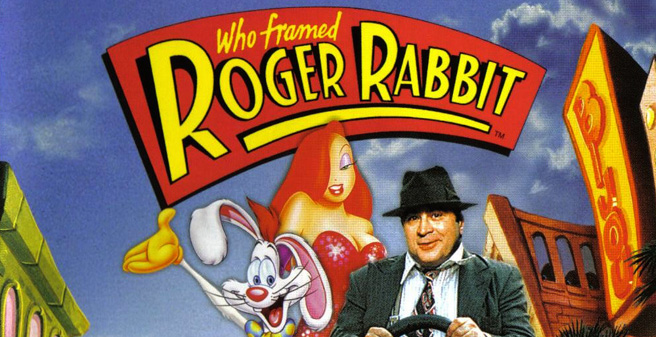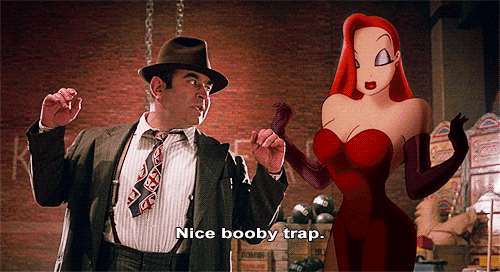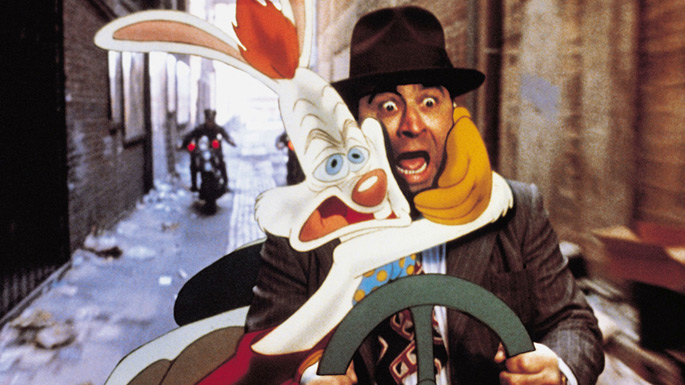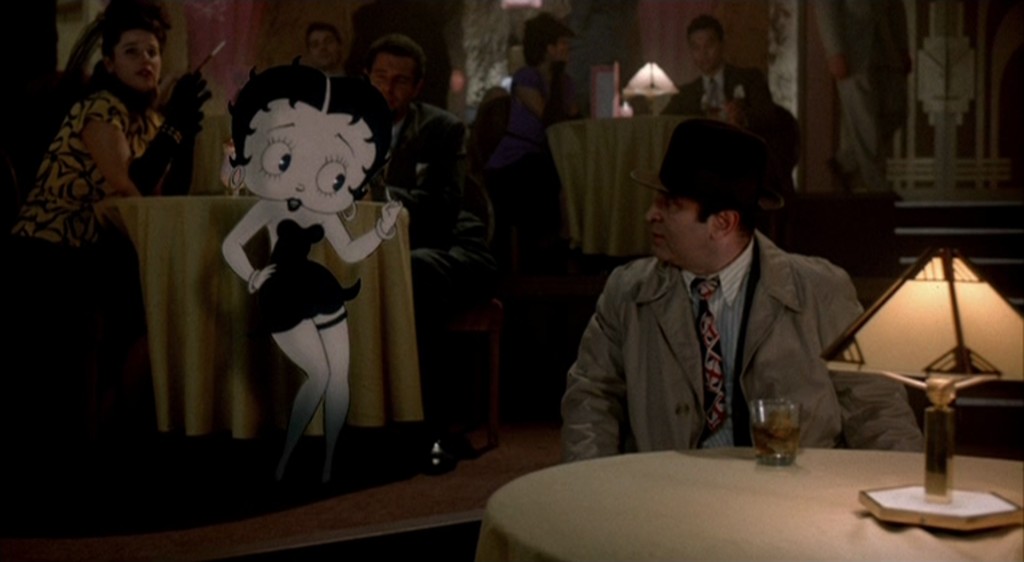 How Does This Hold Up? is a series where Alex and a guest check out a movie they haven’t seen in ages or that they’ve always been meaning to watch. They’ll compare the experience of watching these movies now to when they first saw or heard of them and explore the differences there-in.
How Does This Hold Up? is a series where Alex and a guest check out a movie they haven’t seen in ages or that they’ve always been meaning to watch. They’ll compare the experience of watching these movies now to when they first saw or heard of them and explore the differences there-in.
Alex: Flashing way back for this edition! I’m joined by Karen this week as we revisit one of the seminal films of my childhood: Who Framed Roger Rabbit? Personally, this is a movie that I probably saw for the first time before I could even walk. Actually,my parents are here, so I’ll just ask them…they report back that I was too young to see it in theaters. Understandable, since I was 14 months old when it was released. So my introduction to this was our VHS copy, which got watched around a trillion times, by my scientific estimate. That tapered off as I got towards middle-school and the like, but I recall watching this at some point in college. Point is, I could recall parts of this movie vaguely and had warm feelings towards it, but things like plot details and specific jokes were not at the ready. So, of course, I chose to screen it for my Film History class at Harold Washington College two weeks ago. We’ll get to how I reacted to it. For now, Karen, I want to know what your past relationship with Roger Rabbit was.
Karen: I haven’t seen Who Framed Roger Rabbit in at least two decades. I was closer to 2.5 when the movie came out, and I know I watched it more than once as a kid, but my viewings had definitely tapered off by the time I was school-aged and I was too young for most of the humor. My lasting impression of the movie was that it was super creepy, especially the end. I think the death of that sweet, innocent shoe at the beginning really scarred me.
Alex: Yeah, it was freaky at points. I remember curling up in terror at every appearance of The Dip when I was a child. Even the scenes where R.K. Maroon is assassinated and Eddie is way-laid in Toon Town were tense affairs. Like you mentioned, a lot of the humor, especially the sexual innuendo around Jessica, flew over my head as well. Which all circles around a main theme: this is not much of a kids’ movie. That was on purpose, obviously, but watching it in class as a full-blown adult made that point abundantly clear. The cartoon-y stuff works really well as children’s entertainment, especially the opening short, but the movie leaves that behind for long stretches of time in order to be a neo-noir. Which seems like a fine point to kick it back to you on, Karen: which part of this movie works better?
Karen: In the first 20 minutes, I found myself wondering repeatedly what the target audience was for this movie. I’m still not sure I know. On IMDB, it’s compared to Space Jam and Hook, but WFRR is much darker than either of those movies.
Ultimately I think the adult pieces worked better because this is an adult movie. Kids love the cartoons bits, but they’re the sideshow to the main story, and the innocence of the cartoon characters is repeatedly undercut when we see them “off camera” (think Baby Herman’s fifty year-old lust and three year old dinky).
According to IMDB, Who Framed Roger Rabbit is an homage to Chinatown (1974), a true noir film starring Jack Nicholson and Faye Dunaway. There were negotiations to make two sequels to Chinatown, but they fell through. WFRR actually has the same basic plot as that unmade second sequel. That being said, this movie isn’t straight noir. It’s too zany. The tone of the movie feels more Gilliam than Hitchcock.
In thinking about this, I think I’ve figured out one of my problems with the movie: the cartoon characters. There are cameos from Mickey and Buggs, Betty Boop, Yosemite Sam, characters from Disney, Warner Brothers, and even Hanna-Barbera. They’re silly and surprising, and even kind of delightful. They also make zero sense to me. The cameos are fun, but they don’t aid the storytelling. The movie could have been made as well or better without the famous toons. The cameos fall flat.
I hate saying this, but in rewatching, I think the movie as a whole fell flat. It’s fun. It’s crazy, and dark, and mad. It just wasn’t that satisfying. The movie is trying to tell two different love stories, convey the destruction of an idyllic society by a cardboard (cartoon) villain, and shove a tragic character backstory down our throats. It’s too ambitious for 108 minutes. Pardon the pun, but the characters all feel two dimensional. How did the movie hold up for you, Alex?
Alex: Before I get to anything else, I want to vouch for at least one of those cameos. The Donald and Daffy Duck dueling pianos sequence is sublime. I love both of those characters and their murderous antipathy towards each other is both pitch-perfect and hilarious.
Anyway, It held up pretty well to me, in that it did exactly what it wanted to: make a spectacular and entertaining homage to two Hollywood genres. I screened it in my Film History class as an example of Hollywood Blockbusters, and I think it fits that role to a T. It has big setpieces based around humor and action, its narrative moves at a fast pace, and its high-concept makes it easy to sell in posters and trailers. Just like Back to the Future, the Zemeckis/Spielberg collaboration that preceded it, Roger Rabbit is a sterling example of nostalgia and genre excitement built through solid cinematic craftsmanship.
That being said, it’s not a great movie, at least not for me. My above description of Roger Rabbit, and the nostalgic blockbuster in general, is such a limited type of movie that it winds up feeling underwhelming, even as it satisfies. It’s the Catch-22 of blockbuster filmmaking: either you’re so stylish that the substance suffers or you focus on substance to the chagrin of audiences that love style. Zemeckis has always trended towards the former, even when the material calls for the latter. Roger Rabbit is definitely a prime example of that, where the noir half of the movie feels cynical and insightful, but gets swallowed up by cartoon zaniness and happy endings. Forrest Gump, which won Zemeckis an Oscar for Best Director is an even better example, though I’ll save the specifics about that one for a future column.
Karen, I’ll send it back to you one last time with an alternate history scenario sure to make you sad: How do you think Roger Rabbit would have held up if Terry Gilliam, who was offered the director’s chair by Spielberg, had taken the job?

Decent pun. Also, this is weird content for a kids’ movie.
Karen: You’re a mean one, Mr. Bean. Gilliam, like Zemeckis, occasionally sacrifices content on the altar of style. The Imaginarium of Doctor Parnassus is a terrific example. But when Gilliam gets it right (Brazil) he really gets it right.
Terry Gilliam’s Who Framed Roger Rabbit would not have the “who is the target audience” issue. It would be an adult movie without any shadow of a doubt. It would still be zany, but the movie with be darker, the noir elements highlighted. There is already an element of contrast between Toon Town and the human Hollywood. You have parallel femme fatales that mark the differences between cartoon ideal and (lightly romanticized) reality. The slightly bumbling and ineffective human cops and their weasel counterparts. Gilliam would have dialed up the contrast, giving more voice to innocence and its corruption.
There are two flavors of nostalgia movies: those that capitalize on our nostalgia to sell the movie, playing it mostly straight, and those that undermine nostalgia, making us question whether or not it is really wise to look back. In its current form, Who Framed Roger Rabbit doesn’t do either of those things well. It’s a summer blockbuster, limited by its form (and the rules of character usage and copyright). It’s supposed to capitalize–there are lots of cameos from familiar favorites, but they’re poorly used. Zemeckis tries to get in the satire by giving us a “look behind the camera” in both a figurative and literal sense (opening sequence) but the move fails because Roger’s character is entirely consistent throughout. Only Baby Herman points to another possible interpretation. Gilliam’s piece would absolutely satirize the nostalgia elements, questioning our assumptions about the characters more than Baby Herman could ever manage on his own. Gilliam’s Roger Rabbit would hit the satire element at the expense of genuine nostalgia.
In thinking about this, I realized what type of story Gilliam would tell with this material: the loss of innocence. We have the pure soul in Roger Rabbit, and his wife who is trying desperately to protect his innocence, and we have an array of the fallen. We have our villain, a truly fallen toon who is trying to destroy what he cannot be, and the others, those who haven’t fallen quite as far and are just trying to get by in a capitalistic, profit-driven world. Gilliam would feel perfectly at home teasing out those themes.
Alex: Heh. I thought you would like that mental exercise. I find Gilliam to be very up and down as a filmmaker, so who knows if he would have gotten Roger Rabbit right, but it was in the midst of his 80’s heyday. It would have been quite the sight, at the very least. Anyway, for what we have here it seems like we’re in agreement.
The Verdict: Only Sorta Holds Up







